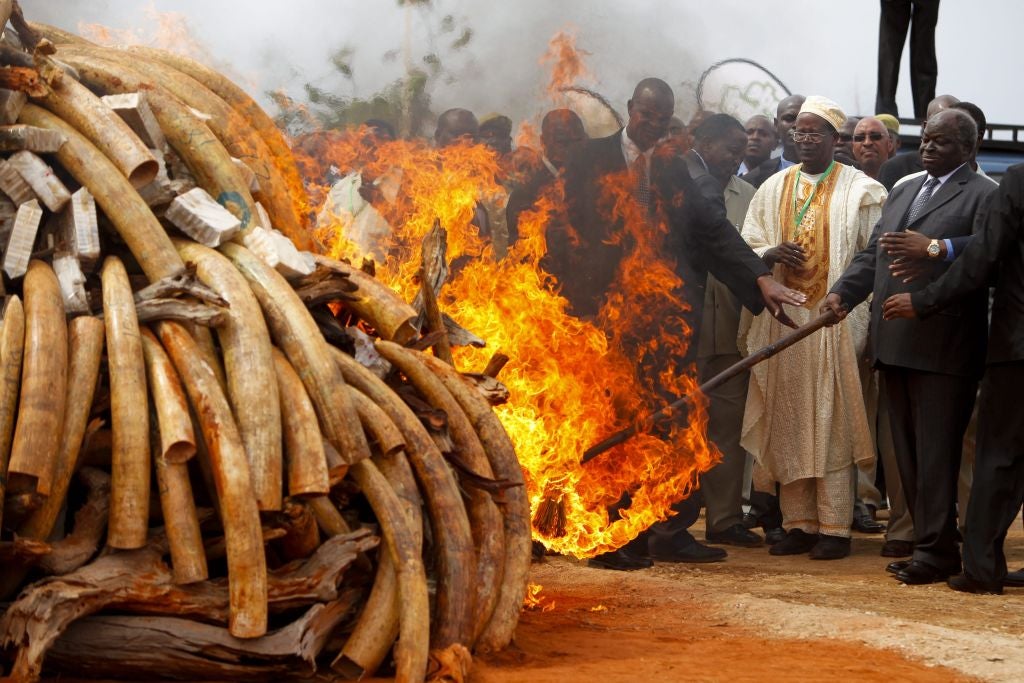Debate: Should ivory stockpiles be destroyed?

The United States has done it. The Philippines and China too. Even Hong Kong has said it will destroy some of its contraband ivory. But ahead of a conservation conference in London next month where world leaders will descend to seek a solution to wildlife crime, the debate about the future of stockpiles is set to heat up.
More than 44 tons of ivory were reportedly seized across the world last year. It is believed to be the largest recovery in a quarter of a century. The situation is urgent: more than 100 African elephants are killed every day.
The ban on the international trade has led to the stockpiling of seized ivory – Hong Kong alone reportedly holds an estimated 33 tons. But what countries do with these collections is disputed. The value of ivory in some places is even greater, per ounce, than gold. Destroying the stockpiles, some conservationists say, will act as a message to poachers that there is no market for the product any more. Others disagree, arguing that the stockpiles are an important resource which should be sold to strengthen conservation efforts.
Ahead of the conference on 12-13 February, The Independent meets two people on different sides of the debate.
Destroy it
Mary Rice is executive director at the Environmental Investigation Agency
There is a straightforward course of action where illegal ivory stockpiles are concerned: destroy them.
By definition, illegal ivory has been procured through criminal activity and should under no circumstances be legitimised. It is standard practice worldwide to destroy seized contraband: drugs, tobacco, fake designer goods, etc, so there is no question of it finding its way into the market place. Destroying contraband goods – or putting them out of commission – should be implemented by all parties as a matter of course after forensic analysis and criminal investigation has been completed.
Seizures of illegal ivory are at record levels. Storing high-value contraband goods is expensive, and a financial burden to countries struggling to find resources to combat the crime that results in confiscation. Tanzania, at the epicentre of the poaching crisis, spends over $100,000 a year on securing its stockpiles, which have grown to massive proportions over the past three decades.
Stockpiles provide temptation and opportunity for corrupt officials to “leak” ivory on to the market: Mozambique and Zambia have “lost” tons of ivory from strong rooms – in the case of Zambia, through the air-conditioning unit. The Philippines cited this enforcement challenge as one of their primary reasons for disposing of all their ivory last year, having lost almost a ton from their “secure” strong room.
We have seen the US and China each destroy around six tons, although in the case of China, this represents only a fraction of what it holds. Hong Kong has announced it will destroy around 28 tons and France is set to destroy its contraband ivory on 6 February.
With the UK Wildlife Crime summit coming up, on 13 February, it will be interesting to see how many other countries declare illegal ivory disposals.
There are many who argue that destroying ivory stockpiles is a waste of resources that could be channelled into conservation. [But] seized ivory represents the proceeds of crime at its most fundamental. The damage is done. Should we not focus on the living rather than on the product of their premature demise?
Sell it
Doug Bandow is a senior fellow at The Cato Institute
Countries are being pressed to destroy ivory stockpiles to reinforce the international ban on ivory sales. However, it would be better to sell the ivory to create economic value in elephants, thereby encouraging their preservation.
Elephants have long been killed for their tusks. The international community tried prohibition. The Convention on the International Trade in Endangered Species of Wild Fauna and Flora (CITES) reported “record levels of ivory were seized” from 2009 to 2011. But the number of elephants still has dropped by nearly two-thirds since 1979.
Corrupt agencies of poor countries are incapable of ending the profitable ivory trade.
Perhaps the biggest problem is lack of incentive for those closest to elephants to help preserve them. Villagers can make money helping poachers. Elephants are the losers.
Policymakers should rethink ivory prohibition. Ivory obtained legally – seized from poachers and illegal sellers or collected from elephants which have been culled or died – should be sold. Licenses also should be offered for controlled hunting of elephants.
Creating an opportunity to kill elephants can make it more likely that more of them will ultimately survive. The money collected should be used to police reserves, offset the harm done by elephants to farmers, and encourage villagers to aid protection efforts.
Several nations in southern Africa have had more success protecting their elephant populations. Today Namibia, South Africa, and Zimbabwe are proposing to sell rather than destroy their ivory stocks.
CITES approved sales in 1999 and 2008 and later found no evidence that the practice increased poaching. Last year CITES predicted: “A legal trade in ivory, elephant hide and meat could change current disincentives to elephant conservation into incentives to conserve them.”
Some activists take offence at the idea of treating elephants as a commodity. But that is why cattle are plentiful while bison almost went extinct in America. Alas, treating elephants as if they are sacred means they are likely to end up dead. It would be better to treat them as commercial and keep them alive.
Join our commenting forum
Join thought-provoking conversations, follow other Independent readers and see their replies
Comments
Bookmark popover
Removed from bookmarks